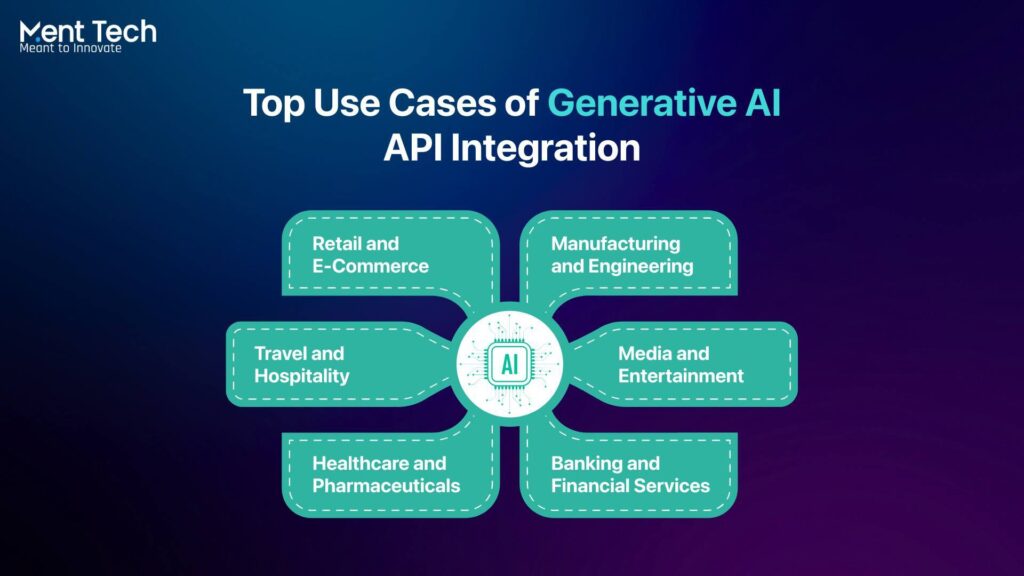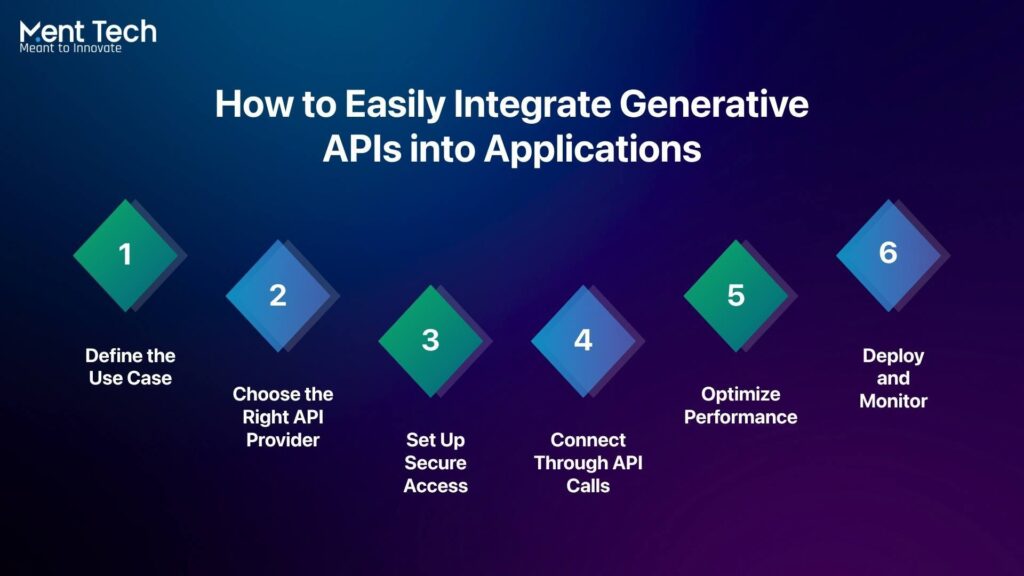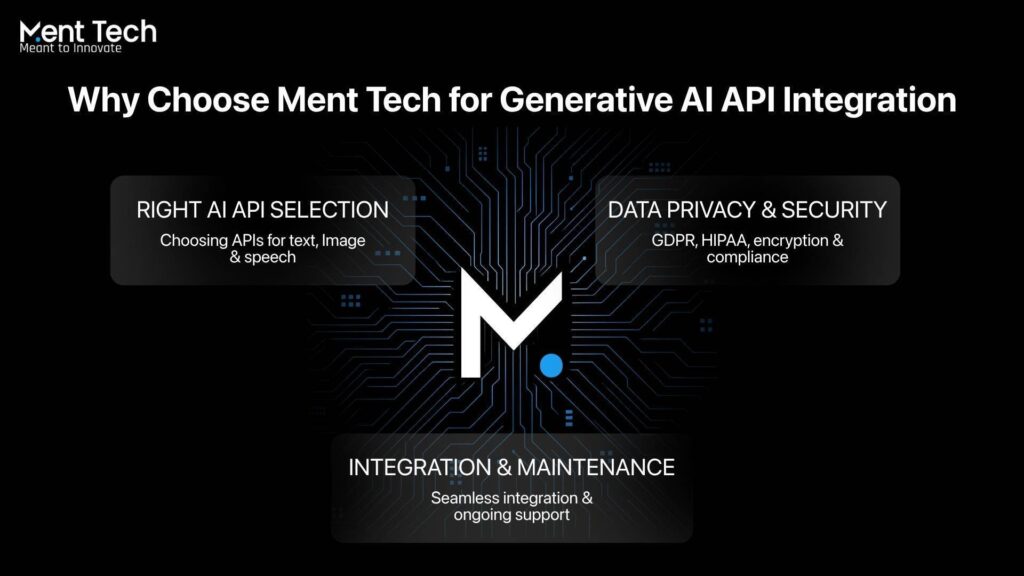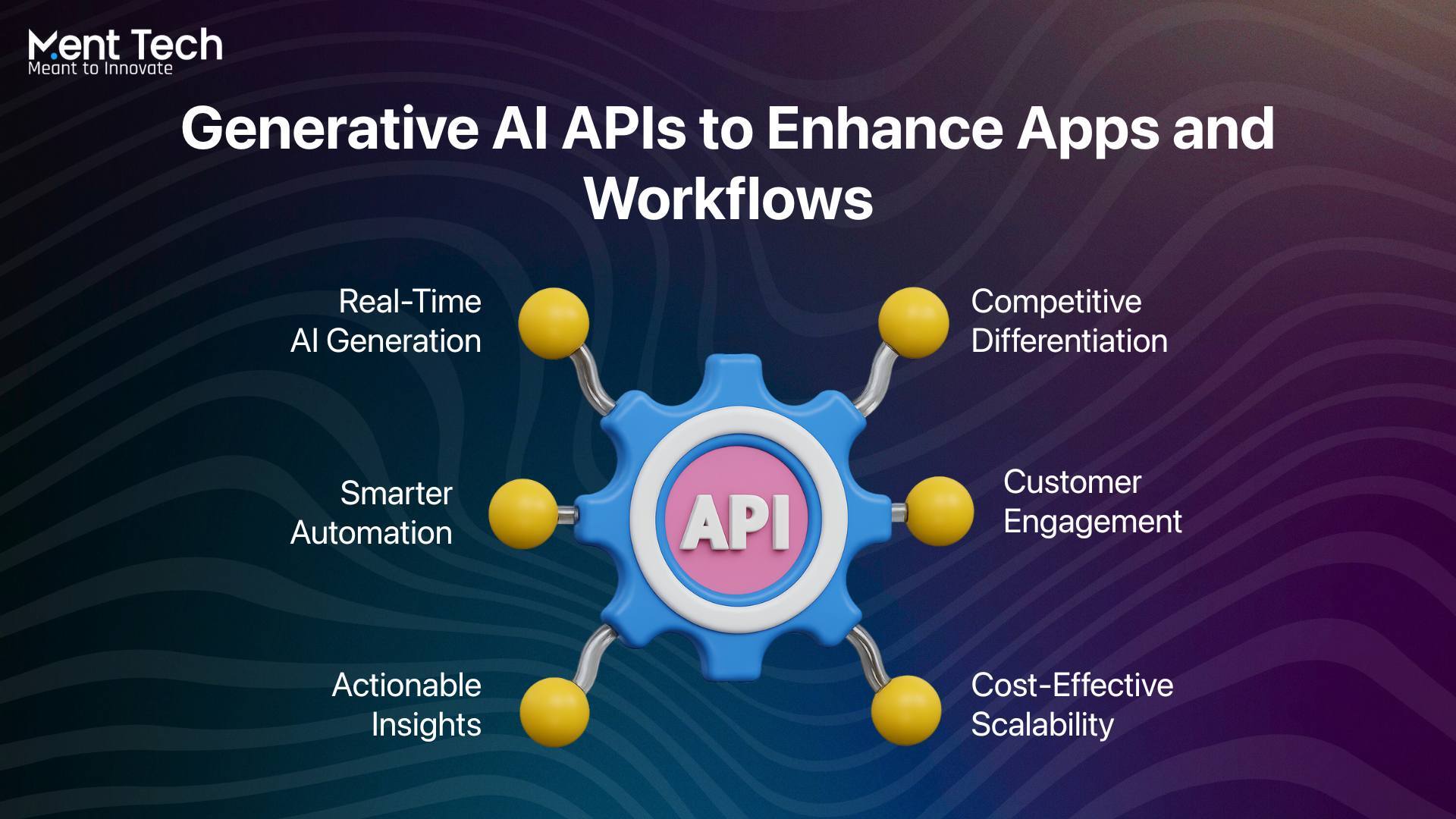Many companies are still struggling to move from experimenting with AI tools to making them a functional part of their products and workflows. This is where generative AI API integration comes in, bridging the gap between innovation and practical application. Gartner predicts that by 2026, more than 80% of enterprises will be using generative AI APIs or applications, a huge leap from less than 5% in 2023.
The challenge lies in the integration process of generative AI. Unlike traditional APIs, a generative AI API introduces creative and adaptive capabilities, which means businesses must carefully address performance, governance, and scalability before adoption can succeed.
This blog will explore what generative AI API integration means, why it matters, and how to integrate generative AI effectively so that enterprises can turn advanced models into real business outcomes.
What Is Generative AI API Integration?
Generative AI API integration refers to the process of connecting your applications with advanced AI models through APIs. Instead of spending years building systems from the ground up, developers can access pre-trained models via a generative AI API and immediately apply their capabilities for text, images, or natural language understanding. Many businesses now adopt AI as a Service to quickly leverage these advanced features without managing complex infrastructure.
In simple terms, these APIs act as a bridge. They make it possible to embed AI-enabled features such as content generation, chat interactions, or speech synthesis directly into your products without reinventing the wheel. This not only reduces time-to-market but also ensures scalability, flexibility, and efficiency.
Today, the integration of generative AI is no longer limited to research or niche projects. Enterprises are embedding it across customer support, marketing automation, product design, and decision-making tools. By using professional generative AI API integration services, businesses gain direct access to powerful models while avoiding the cost and complexity of maintaining infrastructure.
Key Benefits of Generative AI API Integration
Through generative AI APIs, businesses can add features like real-time translation, image generation, and conversational tools. Enterprise AI Integration makes applications more intuitive and responsive without requiring complex development.
1. Smarter Automation and Efficiency
The integration process of generative AI streamlines repetitive tasks and improves productivity. From automated reporting to data analysis, it allows teams to focus on higher-value work while reducing errors.
2. Actionable Business Insights
Generative AI APIs transform complex data into clear insights, revealing patterns, customer behavior, and inefficiencies. These insights drive quicker decisions and support long-term strategies that strengthen overall performance.
4. Competitive Differentiation
Working with a generative AI integration company enables businesses to add advanced features that set them apart. From predictive modeling to custom recommendations, integration drives innovation and market advantage.
5. Improved Customer Engagement
With generative AI integration services, businesses can personalize user journeys, deliver tailored offers, and provide instant support through AI-powered chatbots, increasing satisfaction and loyalty.
6. Cost-Effective Scalability
Instead of building from scratch, companies can learn how to integrate generative AI through APIs that scale efficiently with demand. This reduces costs, simplifies infrastructure management, and ensures the flexibility needed for sustainable growth.

How Generative AI API Integration Works?
Generative AI API integration follows a structured flow where every request is verified, processed, and optimized before delivering results. This ensures security, reliability, and scalability in real-world use.
1. API Gateway
The API gateway is the entry point that handles requests from applications. It routes traffic efficiently and ensures smooth communication with backend systems.
2. Authentication Layer
Before a request reaches the AI model, it goes through authentication checks. This step secures data access and verifies that only authorized users can interact with the API.
3. Rate Limiting and Cost Management
To prevent overload and control expenses, APIs apply usage limits and cost monitoring. This helps businesses manage resources effectively while maintaining performance.
4. AI Model Inference Engine
At the core, the inference engine processes requests using advanced models. In many cases, it combines with a vector database through Retrieval-Augmented Generation (RAG) for accurate and context-rich responses.
5. Response Processing and Safety Filters
Before results are returned, the output is refined and filtered. This ensures responses are safe, reliable, and aligned with compliance standards.
Real-World Example: Spotify with Google Gemini
A strong example of the challenges and solutions in generative AI API integration is Spotify’s move to enhance its music recommendation system. In 2024, Spotify tested Google’s Gemini API to power smarter playlists and personalized suggestions across global markets.
The challenge was delivering real-time recommendations across millions of users while maintaining speed and data privacy. Handling streaming data and generating context-aware suggestions placed heavy demand on performance and infrastructure.
The solution involved applying Gemini’s multimodal AI capabilities to analyze user behavior and preferences in real time. Spotify paired the generative AI API with caching layers and hybrid deployment models, ensuring data remained secure while latency stayed low.
The outcome was more relevant playlist suggestions, voice-driven search results, and dynamic mood-based recommendations. This not only improved engagement but also positioned Spotify as a leader in AI-driven personalization.
This example shows how generative AI integration services help enterprises strike a balance between innovation, scalability, and compliance. With the right APIs and integration strategies, businesses can push the boundaries of personalization while keeping costs and performance under control.
Top Use Cases of Generative AI API Integration

Businesses in different sectors are already applying generative AI API integration to solve complex problems, improve efficiency, and deliver better user experiences. Here are six impactful use cases across industries:
1. Retail and E-Commerce
Generative AI APIs power personalized product recommendations, automated descriptions, and realistic product mockups. Retailers use these capabilities to increase conversions and create more engaging shopping experiences.
2. Travel and Hospitality
Airlines and hotels use generative AI chatbots to handle booking queries, manage customer requests, and deliver real-time updates. This reduces call center traffic while improving traveler satisfaction.
3. Healthcare and Pharmaceuticals
From analyzing medical images to accelerating drug discovery, generative AI APIs are transforming healthcare. They enable faster diagnostics, personalized treatment planning, and advanced research in biotechnology.
4. Manufacturing and Engineering
In manufacturing, APIs support AI-driven design, rapid prototyping, and production optimization. Engineers can generate multiple design variations, cut material waste, and improve efficiency in large-scale operations.
5. Media and Entertainment
Content creators leverage generative AI to draft scripts, produce visuals, and generate voice outputs. Streaming platforms use it to recommend shows and personalize user experiences at scale.
6. Banking and Financial Services
Banks deploy generative AI APIs and AI for KYC solutions for fraud detection, automated customer support, and risk analysis. These integrations enhance compliance, strengthen security, and improve the overall customer experience.
How to Easily Integrate Generative APIs into Applications?

Discover new possibilities by adding smart, dynamic features to your apps. Enhance functionality and user experience seamlessly with this easy guide. Make your applications work smarter and more efficiently with ease.
1. Define the Use Case
Start by identifying where generative AI adds the most value: customer support, content creation, code automation, or personalization. Clear goals guide the integration process of generative AI.
2. Choose the Right API Provider
Evaluate providers like OpenAI, Google Gemini, or Anthropic based on scalability, pricing, compliance, and features. Pick the one that matches your business requirements.
3. Set Up Secure Access
Implement authentication keys and encryption. Ensure sensitive data is anonymized before sending requests to keep compliance risks low.
4. Connect Through API Calls
Use simple REST or SDK calls to integrate the API with your application. Most APIs provide ready-to-use documentation and examples, making this step straightforward.
5. Optimize Performance
Add caching, batching, or hybrid models to control cost and latency. This ensures responses stay fast, accurate, and budget-friendly.
6. Deploy and Monitor
Roll out the integration gradually. Track performance, token usage, and user satisfaction. Keep updating prompts, safety filters, and workflows as your needs evolve.
Why Choose Ment Tech for Generative AI API Integration?

At Ment Tech, we focus on three core priorities that ensure your generative AI API integration is seamless, secure, and built for long-term success. These priorities guide every project we deliver and help businesses adopt AI with confidence.
1. Selecting the Right Generative AI API
We help you choose the right generative AI API for text, image, or speech tasks, evaluating performance, scalability, and compatibility. Using Adaptive AI, we ensure your solutions evolve and improve as business needs change.
2. Ensuring Data Privacy and Security
At Ment Tech, security comes first. We apply encryption, anonymization, and compliance with global standards like GDPR and HIPAA so your integration remains trustworthy and protected.
3. Managing Integration and Maintenance
Our work doesn’t end at deployment. We provide smooth integration with your existing systems and ongoing maintenance, ensuring your generative AI features stay reliable, efficient, and ready for future demands.
Common Challenges in Generative AI API Integration
Generative AI APIs are powerful, but putting them into real business systems is rarely straightforward. From data security to cost spikes, every hurdle needs a practical solution. Here are the most common challenges companies face with generative AI API integration.
1. Protecting Sensitive Data
Customer and business information must remain secure when passing through APIs. Companies address this with anonymization, encryption, and hybrid setups that reduce exposure to risks.
2. Tackling Slow Response Times
Delays in responses break the user experience in apps and chatbots. Teams improve speed through caching, batching multiple requests, and lighter models for quicker outputs.
3. Managing Rising Costs
Usage-based pricing can scale faster than expected and increase bills. Businesses manage this by tracking usage, applying spending limits, and balancing model sizes.
4. Meeting Regulatory Requirements
Strict rules like GDPR and HIPAA govern how personal data is handled. Organizations meet them by running audits, localizing storage, and using compliance-ready APIs.
5. Reducing Inaccurate Outputs
Generative AI sometimes produces outputs that appear correct but are wrong. Companies reduce this by adding validation checks and cross-referencing trusted databases.
6. Avoiding Vendor Lock-In
Depending on a single provider creates long-term risks for businesses. Abstraction layers make it easier to switch providers without disrupting existing systems.
7. Handling Integration Complexity
Legacy systems are rarely designed for AI workloads at scale. Many businesses start small with pilot workflows and expand gradually as adoption grows.
Final Thoughts
Generative AI API integration is changing how businesses innovate and compete. It simplifies workflows, accelerates development, and enables personalized user experiences that drive measurable growth. Companies that move early gain advantages in efficiency and customer satisfaction, while those who delay risk falling behind in a fast-changing market.
Ment Tech, a leading Generative AI Development company, recommends beginning with focused use cases that deliver immediate value and expanding gradually into larger workflows. The key lies in aligning integration with business objectives, building secure pipelines, and preparing teams to adopt new capabilities with confidence.
With the right strategy, generative AI becomes more than an add-on; it becomes a driver of smarter decisions and sustainable growth. Hire AI developers through MentTech to explore secure, scalable, and effective generative AI API integration for your business today.
FAQs
Yes, many providers offer free tiers to experiment with AI. Hugging Face provides serverless inference, AssemblyAI offers limited transcription, and Google Cloud has a free allowance for AI services. Open-source projects on GitHub also let developers explore without major costs, though with usage limits.
The three main types are Generative Adversarial Networks (GANs), Variational Autoencoders (VAEs), and Transformer Models. GANs are great for realistic images and video, VAEs excel at producing variations of data, and transformers power text-based tasks like chatbots and summarization.
Integration usually begins with reviewing the API documentation for endpoints and authentication. Most APIs are REST-based, making them easy to work with. Developers can quickly connect, send data, and receive AI-generated outputs without managing complex infrastructure.
They’re commonly applied in product descriptions, ad copy, video scripts, personalized emails, and chatbot interactions. Many businesses extend this with Generative AI Development Services to create more tailored solutions.
Security, compliance, scalability, and smooth integration are key. Expert Generative AI Consulting Services help enterprises choose the right API and ensure long-term reliability.


